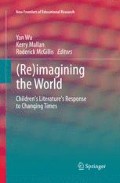Abstract
For over 2000 years, while Chinese texts acknowledged children simply based on age, there was little written to cater for them as a distinct group of people with specific needs. In the early twentieth century, however, Chinese intellectuals ‘discovered’ childhood and created a modern literature for children. This literature experienced a series of dynamic changing representations of childhood, responding to the political needs of the times. This chapter focuses on this evolution, examining four distinctive periods: the dynastic period till 1911; the Republican period from 1911 to 1949; Mao’s socialist phase from 1949 to 1976; and the post-Mao ‘new era’ from 1976 to 2000. These changes have to be understood in China’s historical and socio-cultural contexts.
Access this chapter
Tax calculation will be finalised at checkout
Purchases are for personal use only
References
Bi L (2003) Capitalist bears and socialist modernisation: Chinese children's literature in the post-Mao period. Children's literature in education 34(1):57–63
Bi L (2013) China's patriotic exposé: Ye Shengtao's fairytale, Daocaoren [Scarecrow]. Bookbird: A journal of international children's literature 51(2):32–38
Bing X (1923) Fanxing [Stars]. Shangwu yinshuguan, Shanghai
Cao W (1988) Zhongguo bashiniandai wenxue xianxiang yanjiu [Study of the phenomena of Chinese literature in the 1980s]. Peking University Press, Beijing
Chang J (1992) Wild swans. HarperCollins, London
Cui D (1956) Duiyuan de daolu [The road of a Young Pioneer member]. Shaonian wenyi, Shanghai. (Reprinted (1979) in Selected works of Shanghai children’s literature, 1949–1979, vol. 1. Shaonian ertong chubanshe, Shanghai, pp 131–149)
Diény J-P (1971) Le Monde est à Vous: La Chine et les Livres pour Enfants. Gallimard, Paris
Du G (1950) Xinde ertong wenxuede dansheng [The birth of a new children’s literature]. Wenhui bao. (Reprinted in Zhongguo ertong wenxue daxi, lilun I, Jiang F (ed), 1988. Xiwang chubanshe, Shanxi, pp 375–381)
Du C (2000) Lun Zhou Zuoren de ertong wenxueguan [On Zhou Zuoren’s views on children’s literature]. J North Sichuan Educ Coll, 10(4):19–22
Fang X (2003) Neo-confucianism in chinese children’s books. Papers: exploration into children’s literature 13(2):15–26
Fang X and Bi L (2013) Confucianism. In Handbook of research on development and religion, Clarke M (ed), Edward Elgar, Cheltenham UK, pp 124–137
Farquhar M (1999) Children’s literature in China: from Lu Xun to Mao Zedong. An East Gate Book, New York
Feng X (2007) Xiao jing—The classic of xiao with English translation & commentary. http://www.tsoidug.org/Papers/Xiao_Jing_Comment.pdf. Accessed 15 September 2011
He Y (1958) Tonghua yao zhengquede jiaoyu haizi [Fairytales must properly educate children]. Wenyi bao. (Reprinted in Zhongguo ertong wenxue daxi, lilun I, Jiang F (ed), 1988. Xiwang chubanshe, Shanxi, pp 638–649)
He Y (1965) Liu Wenxue. Shaonian ertong chubanshe, Shanghai
Huang Z (ed) (1972) Zhou Zuoren lunwenji [Collection of Zhou Zuoren’s treatises]. Huiwenge shudian, Hong Kong
Legge J (1899) Sacred books of the east, vol. 3, 2nd edn. Clarendon Press, Oxford
Li B (1950) Jianshe ertong wenxue [Build up children’s literature]. Guangming ribao. (Reprinted in Zhongguo ertong wenxue daxi, lilun I, Jiang F (ed), 1988. Xiwang chubanshe, Shanxi, pp 371–374)
Lin J (1972) Modern chinese poetry: an introduction. University of Washington Press, Seattle and London
Liu X (1977) Banzhuren [The class teacher]. Renminwenxue, vol. 11, Beijing. http://www.rain8.com/article/class6/2232.htm. Accessed 4 October 2012
Liu X (1984) Wo ke bupa shisansui [I am not afraid of being thirteen years old]. Dongfang shaonian. (Reprinted in Zhongguo ertong wenxue daxi, xiaoshuo II, Pu M (ed) 1988. Xiwang chubanshe, Shanxi, pp 711–729
Lu B (ed) (1957) Xiao pengyou [Little friend]. Shaonian ertong chubanshe, issue 21, Shanghai
Lu B (ed) (1980) 365 ye gushi [Stories for 365 nights]. Shaonian ertong chubanshe, Shanghai
Lynch M (1996) China: from empire to people’s republic 1900–49. Hodder Murray, London
O’Sullivan E (2005) Comparative children’s literature. Routledge, London
Renmin jiaoyu chubanshe xiaoxue yuwen bianjishi [People’s education publisher primary school Chinese language textbook compilation office] (1965) Yuwen [Chinese language], Renmin jiaoyu chubanshe, vol. 6, Beijing
Wu M (1991) San zi jing, bai jia xing, qian zi wen [The three character classic, a hundred family names and an essay of a thousand characters]. Shanghai guji chubanshe, Shanghai
Xin san zi jing bianxie weiyuanhui [The new three character classic compilation committee] (1994) Xin san zi jing [The new three character classic]. Guangdong jiaoyu chubanshe, Guangzhou
Yan W (1956) 1954–1955 Ertong wenxue xuan xuyan [Preface to selected works of children’s literature 1954–1955]. (Reprinted in Zhongguo ertong wenxue daxi, lilun I, Jiang F (ed), 1988). Xiwang chubanshe, Shanxi, pp 398–408
Ye S (1923) Daocaoren [The scarecrow]. Shangwu chubanshe, Shanghai
Yu H (1993) Zai xiyuzhong huhan [Cries in the drizzle]. Shanghai wenyi chubanshe. http://book.kanunu.org/html/2005/0716/374.html. Accessed 27 March 2012
Zhang T (1932) Dalin he Xiaolin [Big Lin and Little Lin]. Beidou Monthly, 2 (1,3,4). (Reprinted (1956) by Zhongguo shaonian ertong chubanshe, Beijing)
Zhou Z (1920) Ertong de wenxue [Literature for children]. Xin qingnian [The new youth] 4(8). (Reprinted in Zhongguo ertong wenxue daxi, lilun I, Jiang F (ed) 1988. Xiwang chubanshe, Shanxi, pp 3–10)
Author information
Authors and Affiliations
Corresponding author
Editor information
Editors and Affiliations
Rights and permissions
Copyright information
© 2013 Springer-Verlag Berlin Heidelberg
About this chapter
Cite this chapter
Bi, L., Fang, X. (2013). Childhoods: Childhoods in Chinese Children’s Texts–Continuous Reconfiguration for Political Needs. In: Wu, Y., Mallan, K., McGillis, R. (eds) (Re)imagining the World. New Frontiers of Educational Research. Springer, Berlin, Heidelberg. https://doi.org/10.1007/978-3-642-36760-1_5
Download citation
DOI: https://doi.org/10.1007/978-3-642-36760-1_5
Published:
Publisher Name: Springer, Berlin, Heidelberg
Print ISBN: 978-3-642-36759-5
Online ISBN: 978-3-642-36760-1
eBook Packages: Humanities, Social Sciences and LawEducation (R0)

